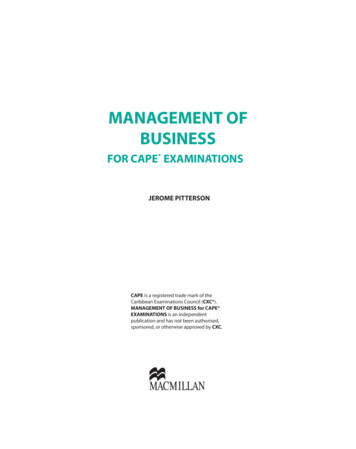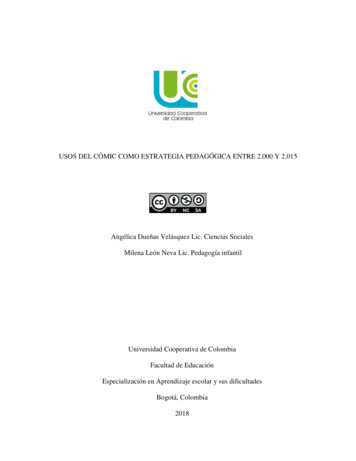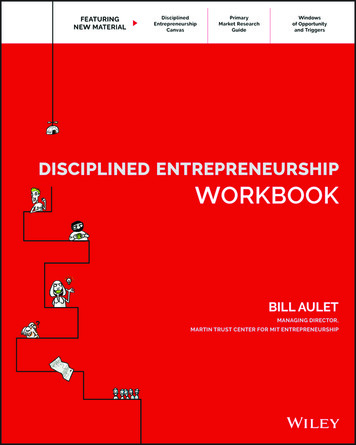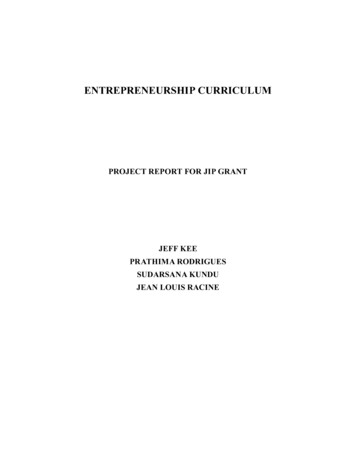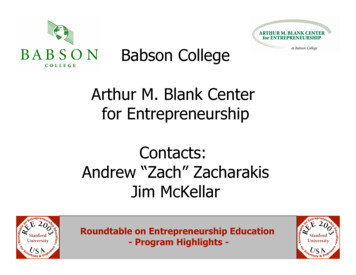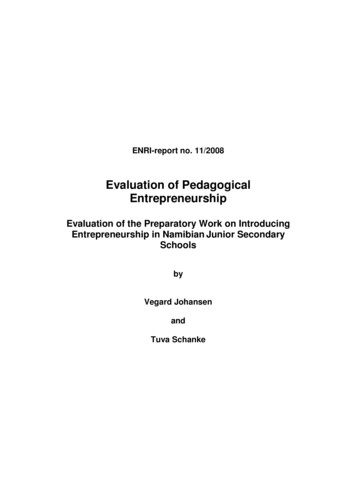
Transcription
ENRI-report no. 11/2008Evaluation of PedagogicalEntrepreneurshipEvaluation of the Preparatory Work on IntroducingEntrepreneurship in Namibian Junior SecondarySchoolsbyVegard JohansenandTuva Schanke
ENRI-report no. 11/2008Evaluation of PedagogicalEntrepreneurshipEvaluation of the Preparatory Work on IntroducingEntrepreneurship in Namibian Junior SecondarySchoolsbyVegard JohansenandTuva Schanke
Title:Evaluation of Pedagogical Entrepreneurship. Evaluation of thePreparatory Work on Introducing Entrepreneurship in Namibian JuniorSecondary SchoolsAuthors:Vegard Johansen and Tuva SchankeENRI-report -632-4Project-no.:10265Project Name:Entrepreneurship in NamibiaProject Assignor:The Namibia Association of Norway (NAMAS)Project leader:Vegard JohansenSummary:The project assignor for this study is the Namibia Association of Norway(NAMAS). NAMAS is an international non-profit organisation started as asolidarity organisation for the people of Namibia in 1980. NAMAS iscurrently working on four education projects in Namibia, one of which is“Pedagogical Entrepreneurship”.In 2004, the Ministry of Education of Namibia (MOE) decided to introduceEntrepreneurship as a new subject in Junior Secondary Schools. TheNational Institute for Educational Development (NIED) was tasked to putthis decision into practice. The preparatory work on the introduction ofEntrepreneurship was completed in the period 2006-08. In this period,NAMAS has provided direct economic assistance, strategic assistance,and has supported an expert group from Hedmark University College(HUC) with its involvement in the process of pre-service training, inservice training, and the development of teaching methods, curricula andother written materials.In May 2008, the Eastern Norway Research Institute was chosen toevaluate the role of NAMAS in assisting the MOE with the introduction ofEntrepreneurship. Our work is finalised with this report. The conclusionsin this report are based upon the following data gathered in Norway andNamibia: Individual interviews with two teachers involved in the pilotgroup; three group interviews with learners; a group interview withrepresentatives from one College of Education; and individual interviewswith the chair of the steering committee, the Entrepreneurship coordinator(leading the pilot group), the director of NAMAS and the project leaderfrom HUC.Subject headings:Entrepreneurship, evaluation, young people, education, Namibia.Date:October 2008No. of pages:64Price:15 Euro (120 NOK)Publisher:Eastern Norway Research Institute (Østlandsforskning)Postboks 2232601 LillehammerTelephone: 61 26 57 00Telefax: 61 25 41 65e-mail: post@ostforsk.nohttp://www.ostforsk.no7
8
PrefaceThe project assignor for this study is the Namibia Association of Norway (NAMAS). NAMASis a small international non-profit organisation. NAMAS supports the Namibian people andother people in Southern Africa working for democratic development, respect for human rights,and economic and social justice. The organisation has four employees in Namibia and threeemployees at the main office in Elverum (Namibiahuset). Currently, NAMAS is working on thefollowing ongoing education projects: Indigenous peoples programme with the Himba and Sanpeoples focusing on education and strengthening civil society; Traditional Life Skills Project forKaras and Erongo Regions; and Pedagogical Entrepreneurship with a national approach.In May 2008, the Eastern Norway Research Institute (ENRI) was chosen to evaluate the role ofNAMAS in assisting the Ministry of Education of Namibia in the area of Entrepreneurship. Thetime period to be assessed was 1 January 2006 to 30 June 2008. In the planning phase (2006-08)a pilot group was appointed. This pilot group included members from seven Junior SecondarySchools and two Colleges of Education. In the period 2006-08, NAMAS provided directeconomic support, was a strategic partner, and paid for expertise from Hedmark UniversityCollege (HUC) for assisting in the process of developing teaching methods, pre-service training,in-service training and development of curricula and other materials.ENRI would like to thank a number of people for their contribution to the success of thisevaluation. Special thanks go to the director of NAMAS, Svein Ørsnes, for his initiativeregarding this evaluation and collaboration during the process. We also thank DavidGroenewald for organising the field study in Namibia. In addition to Svein and David, wewould like to thank all informants for their participation.Lindsay Wærø has helped with the editing of the report.Lillehammer, October 2008Torhild AndersenHead of researchVegard JohansenHead of project9
ContentsPreface. 9Contents . 1012345Introduction . 131.1Some facts about Namibia. 131.2Background for the subject Entrepreneurship . 141.3Key actors. 161.4Structure of the report . 18Method . 192.1The semi-structured interview. 192.2The phenomenological interview . 202.3Group interview. 202.4Norway and Namibia; challenges across borders. 22NAMAS . 233.1Overall experience. 243.2Cooperation with different parties. 243.3Future challenges. 25HUC. 274.1The role of HUC. 274.2Overall experiences and success factors . 284.3Challenges . 294.4Cooperation with NAMAS. 304.5Cooperation with PG and NIED. 304.5Visions for the future. 31NIED. 335.1Entrepreneurship coordinator . 335.1.1The overall experience . 335.1.2Cooperation in the PG . 345.1.3Cooperation with HUC and other actors . 345.1.4Future visions . 3510
5.2Chair of the ESC . 365.2.1Overall experience. 365.2.2The PG . 375.2.3Cooperation with HUC. 375.2.4Politicians . 375.2.5Future visions . 3867College of Education . 396.1Overall experiences with the pilot group . 396.2Experienced challenges . 406.3Cooperation with other parties . 416.4Needs for the future. 41The teachers. 437.1Teacher 1. 447.1.1Overall experiences with the pilot group . 447.1.2Teaching Entrepreneurship. 447.1.3Cooperation within the Pilot Group . 457.1.4Cooperation with other parties . 457.1.5Visions for Entrepreneurship. 467.2Teacher 2. 477.2.1Overall experiences with the pilot group . 477.2.2Teaching Entrepreneurship. 477.2.3Cooperation within the pilot group . 487.2.4Cooperation with other parties . 487.2.5Visions for Entrepreneurship. 498The learners . 518.1School 1. 518.1.1Highlights and entrepreneurial competences. 518.1.2Challenges . 528.1.3Business start ups . 538.1.4Class relations . 538.2School 2. 548.2.1Highlights and entrepreneurial competences. 548.2.2Challenges . 558.2.3Business start ups . 558.2.4Class relations . 569Summary. 579.1The function of pre-service training. 579.2The function of in-service training. 589.3The use and integration of methodologies in teaching. 599.4Advice for continued work on Entrepreneurship . 60References . 6311
12
1 IntroductionIn 2004, the Ministry of Education of Namibia (MOE) decided to introduce Entrepreneurship asa new subject in Junior Secondary Schools. The National Institute for Educational Development(NIED) was tasked to put this decision into practice. From 2008, Entrepreneurship has beenintroduced in the 8th Grade. It will begin in the 9th Grade in 2009 and the 10th Grade in 2010.The main concern of this evaluation and this report is the period of planning andimplementation (2006-08).From 2006 to 2008, the Namibia Association of Norway (NAMAS) provided direct economicassistance, strategic assistance, and paid an expert group from Hedmark University College(HUC) and Hedmark County for their involvement in the process of pre-service training, inservice training and development of teaching methods and curricula. As such, NAMAS hasplayed an active part in the development of pedagogical entrepreneurship in Namibia.The Eastern Norway Research Institute was appointed to evaluate the assistance provided byNAMAS to the MOE in the time period 2006-08.This report is based upon qualitative data gathered in Norway and Namibia. We have carried outindividual interviews with two teachers involved in the pilot group, the chair of the steeringcommittee, the Entrepreneurship coordinator (leading the pilot group), the director of NAMASand the project leader from HUC. We have also performed three group interviews with learners,and a group interview with representatives from a College of Education,This chapter introduces Namibia, the background for introducing Entrepreneurship in NamibianJunior Secondary Schools, and the relevant parties working with the planning andimplementation of Entrepreneurship. The last section discusses the structure of the report.1.1Some facts about NamibiaColonised by Germany in 1884, Namibia was administered by South Africa from 1917 to 1990.From 1966 to 1989, the liberation movement (Swapo) struggled against South Africa. Namibiabecame independent in 1990 (Namibia Tourism 2008). Although Namibia is free, many socialstructures are still coloured by the after-effects of colonial times and the apartheid regime.13
Namibia is geographically situated along the south-western coast of the African continent. Thecountry has borders with Angola, Zambia, Botswana and South Africa. For administrativepurposes, Namibia is divided into 13 regions. Namibia has an aerial surface four times the sizeof Great Britain, but there are only around 2.2 million residents. There are some denselypopulated areas in the North, whilst areas in the South are very sparsely populated (ibid.).13 ethnic groups live side by side in Namibia, adding to the cultural diversity. 87 percent of thepopulation are black, 6 percent are white and 7 percent are mixed. The mean and median age iscomparatively low, as 38 percent of the population are less than 15 years of age, 58 percent arebetween 15 and 64 years, and only 4 percent are 65 years or older (NAMAS 2006).All Namibian ethnic groups have their own specific languages, and as many as 28 languages arespoken. Under the rule of South Africa the official language was Afrikaans, but English becamethe official language following liberation. Still, most Namibians prefer to speak Afrikaans toEnglish, and Afrikaans is the lingua franca between most population groups (ibid.). At the sametime, the fact that English is the official language of Namibia makes it easy for Norwegians tocooperate with Namibians. German is also widely spoken.The Namibian economy centres around agriculture, fishing and mining, accounting for morethan 25 percent of GDP (Namibia Tourism 2008). The Namibian democracy is approaching itssecond decade, and that is a sign of political stability. Since independence, there have been hugeimprovements in sectors such as health and education and transportation systems (roads).However, there are also many unresolved issues, including HIV/Aids, distribution of land andextreme unemployment rates (NAMAS 2006). Namibia has one of the highest levels ofinequality in the world (Gini 0.74) (UNDP 2008).We end this section with a brief discussion about education. Following independence, theNamibian education system was transformed. Education was now supposed to be offered toevery child. This was a fundamental change compared to the previous regime. Furthermore, tenyears of schooling was to be obligatory (lower primary school to upper secondary school)(NAMAS 2006). In the last decades, much has been done, but there is still a long way to gobefore all Namibian children complete ten years of education. According to the UNDP, the adultliteracy rate is 85 in Namibia, and education is the dimension where Namibia performs best onthe Human Development Index. Namibia performs less well on the other two dimensions, lifeexpectancy and standard of living (UNDP 2008).1.2Background for the subject EntrepreneurshipSince Schumpeter produced his ideas on economics, it is generally considered thatentrepreneurial activity is important for economic growth and the creation of more and betterjobs. In the US, entrepreneurship education has been an area of commitment since World War14
II. In Europe, many countries and the European Union holds that entrepreneurship educationshould be one of the core fields in a nation’s education policy (Johansen et al. 2008).Entrepreneurship education is intended to develop young people’s entrepreneurial competences,i.e. their personal abilities (general entrepreneurial abilities); knowledge/skills on how toestablish and run an enterprise (specific entrepreneurial abilities); and attitudes towardsentrepreneurship (be aware of/desire to choose a self-employed career). Many empirical studieshave shown that entrepreneurship education contributes positively to young people’s creativityand self-respect, as well as their skills in cooperation and decision-making. They have alsodemonstrated that this education changes young people’s attitudes towards entrepreneurship,and young people who participate in entrepreneurship education are also more likely to becomeentrepreneurs compared to the general population (see e.g. Johansen et al. 2007).The idea of Entrepreneurship as a subject in Namibian schools dates back to 1999, when thePresidential Commission of Enquiry into Education recommended that the development andimplementation of Entrepreneurship should be accessible to all learners (Groenewald 2006,2007, 2008). Some years passed, with discussions on how to strengthen entrepreneurial skills inschools. In 2004, the Ministry of Education decided to introduce Entrepreneurship as anoptional and promotional subject, to replace Business Management in Grades 8-10.Entrepreneurship thus became one of three subjects in the major option, Commerce.1 It waqsalso decided to integrate entrepreneurship principles into the practical subjects Home Ecology,Design and Technology and Elementary Agriculture in Grades 5 to 7 (ibid.).The main reason for focusing on entrepreneurship education is economic. Namibia’s economyis dominated by imports and by a few large companies owned by previously advantaged groups.Most school leavers and graduates with higher education prefer to hold a secure job as a wageearning employee. The expectation (from politicians and bureaucrats) is that Entrepreneurshipwill promote innovation and increase the number of Small and Medium Enterprises (SMEs). Asthe unemployment rate at the national level stands close to 40 percent, and at 50 percent amongyoung people, it is particularly important to increase the number of self-employed youngpeople. Changing the mindsets of young people with regard to entrepreneurship requires a newconcept in education and training (Groenewald and NIED 2007).Another reason for focusing on entrepreneurship is to tackle drop-out rates. Like Norway,Namibia has a huge problem with school drop-outs. Some Namibian children leave school forreasons such as: the need to fulfil tasks at home (e.g. taking care of younger siblings), getting apaid job, parents who are negative about educational training, school fees, discipline andphysical punishment. There are also some children who drop out because of unqualifiedteachers, unsuitable teaching methods, and books and curricula that are considered to be tootheoretical (NAMAS 2006; Ødegård 2008; interviews at NIED). The subject Entrepreneurshipmay reduce drop-out rates, since this subject is more practical than other subjects, the teachingmethods used are innovative, and the learners are introduced to the business sector.1From 2008 the major option Commerce includes the subjects Accounting, Keyboard & Word Processingand Entrepreneurship. Entrepreneurship is offered as a major specialisation (NIED 2007).15
A third motive for introducing Entrepreneurship is addressing personal skills important inbusiness, in the public sector or private life. Theoretical subjects such as mathematics, languageand technology are traditionally prioritised in Namibian schools. Soft subjects have been lookedupon as less important even though the school is supposed to address social skills, cognitiveskills and communicative skills. Introducing the subject Entrepreneurship is an attempt toaddress different types of personal skills, because it focuses on the ability of the individual tospot opportunities, develop solutions, and be creative and innovative (NIED 2006).Still, there is no doubt that the economic perspective is the most important. Children and youngpeople are to be encouraged to believe in their own creative abilities and be stimulated to takerisks so they can create values and workplaces for themselves and others. The importance ofcreating new SMEs for social and economic development, in particular for reducingunemployment and thus alleviating poverty, is the main goal of the subject Entrepreneurship.Human capital in the form of competence and manpower is one of Namibia’s most vital nationalassets, and educating a new generation of entrepreneurs is a strategy for future financial growthand value creation in Namibia (Groenewald and NIED 2007).1.3Key actorsThe process of implementing Entrepreneurship in Namibian schools has involved a number ofdifferent actors. David Groenewald (NIED), Svein Ørsnes (NAMAS) and Inger Karin RøeØdegård (HUC) have provided different documents enabling us to get the full picture about keyactors and their involvement.The decision to introduce Entrepreneurship was made by the Ministry of Education (MOE). TheMOE is represented in the Entrepreneurship Steering Committee (ESC) and they are responsiblefor all decisions made concerning the introduction of Entrepreneurship.The National Institute for Educational Development (NIED) is a Directorate within the MOE.NIED has the continuous task of ensuring that education in Namibia is developed and improvedin accordance with the needs of the Namibian people and with developments in education.NIED is responsible for evaluating, designing and developing curricula, introducing teachingmethods and educational research, and preparing and coordinating pre-service and in-serviceteacher education. They also provide training in educational management. NIED has led theprocess of introducing Entrepreneurship to Namibian schools.NIED established the Entrepreneurship Steering Committee (ESC) to monitor the developmentand implementation process. This committee is led by William January (CEO of CurriculumResearch and Development at NIED) and includes representatives from the MOE, BankWindhoek and NAMAS (ESC 2005-08).16
NAMAS is a Norwegian non-profit organisation. Its aim is to support the Namibian people andother people in Southern Africa working for democratic development, respect for human rights,and economic and social justice. NAMAS is not a big fund-raising organisation, but has a strongnetwork of expertise to draw on (including resource people at different education institutions,children’s rights organisations and environmental organisations in Namibia and Norway)(NAMAS 2006). NAMAS’ main projects are: Indigenous peoples programme with the Himbaand San peoples focusing on education and strengthening civil society; Traditional Life SkillsProject for Karas and Erongo Regions; and Pedagogical Entrepreneurship with a nationalapproach. Connected to development projects, NAMAS has four employees in Namibia andthree at the main office in Elverum, Norway.A group of entrepreneurship experts from Hedmark University College (HUC) was hired byNAMAS to guide the process of development of Entrepreneurship. HUC has been involved inthe project since late 2004, and it became a key actor from 2005. HUC has been involved in theprocess of developing teaching methods, pre-service training, in-service training anddevelopment of curricula and other material. Its participation in the project includes annualwork trips to Namibia (four trips), as well as organising a visit from the pilot group (PG) inNorway. All of these trips have been packed with seminars, workshops, school visits, meetingsand writing material for colleges and Junior Secondary Schools (Ødegård 2005; 2008).The PG was appointed by NIED. It is led by the Entrepreneurship coordinator DavidGroenewald. He was appointed in 2005 and his position is sponsored by NAMAS. In addition toGroenewald, the PG included one teacher from each of the seven pilot schools and two teachereducators at the two colleges. The PG comprised: Windhoek Teacher College, OngwedivaTeacher College, Hage Geingob Secondary School in Windhoek (Khomas Region), M&KGertze Secondary School in Rehoboth (Hardap Region), J.G. v.d. Wath Secondary School inOkahandja (Otjozondjupa Region), Erundu Secondary School in Oshakati (Oshana Region),Heroes Private School in Ondangwa (Oshikoto Region), Namib High School in Swakopmund(Erongo Region) and Kolin Foundation in Arandis (Erongo Region)In addition to these actors, there are some other relevant parties. These parties are not directlyinvolved in this report, but they should nevertheless be mentioned for their input to the project.The United Nations Industrial Development Organization (UNIDO) and its representative BillyButamanya has been a member of the project group since 2006. Mr Butamanya has beeninvolved in the process of creating the teacher’s guide and other study material, as well asholding courses and workshops. Mr Butamanya has played an important part in relatingEntrepreneurship to an African context (Groenewald 2006, 2007, Ødegård 2008).Bank Windhoek is the private sector partner (Groenewald and NIED 2007). It has been involvedin the entire process of implementing Entrepreneurship. Among other things, it contracted aconsultancy firm – DECOSA – to investigate the problems and opportunities for strengtheningEntrepreneurship skills in schools.17
DECOSA presented its report in 2004. It concluded that the existing educational programmesdid not assist in developing an entrepreneurial culture (DECOSA 2004). DECOSA alsopresented a long list of recommendations to strengthen entrepreneurship education.Other parties to the preparatory phase that we must mention are Shell Namibia and the Germanconsultants InWent. InWent contributed to the “In-service Training of Teachers” in January2008 and June-July 2008.1.4Structure of the reportNamibia has come a long way since it decided to introduce entrepreneurship education. In 2008,Entrepreneurship has been implemented in Grade 8 in “all” Namibian schools. To accomplishthis, many different activities have been important. NAMAS (directly or via HUC or theEntrepreneurship coordinator) has been involved in the following: In-service teacher training: Courses, workshops, and school visits in the PG, as well astwo-week courses for selected Business Management teachers (45 from all regions) tobe trained as “Trainers of Trainers” in order to carry out regional in-service trainingPre-service training: Courses and workshops at the Colleges of Education (which willdeliver future teachers with competence in teaching Entrepreneurship)Curriculum/syllabus development: NIED, HUC and UNIDO have developed curricula,syllabi and teachers’ guides for Junior Secondary Schools and Colleges of EducationFinancial costs: NAMAS has sponsored the Entrepreneurship coordinator position andpaid for materials and coursesStrategic input: NAMAS has presented its views in the ESCThe point of this evaluation is to discuss the assistance provided by NAMAS to the MOE in thearea of Pedagogical Entrepreneurship. The period to be assessed is 2006 to 2008. The “Terms ofReference” (Ørsnes 2008) states
7 Title: Evaluation of Pedagogical Entrepreneurship. Evaluation of the Preparatory Work on Introducing Entrepreneurship in Namibian Junior Secondary Schools Authors: Vegard Johansen and Tuva Schanke ENRI-report no.: 11/2008 ISSN-no.: 0809-11617 ISBN-no.: 978-82-7356-632-4 Project-no.: 10265 Project Name: Entrepreneurship in Namibia Project Assignor: The Namibia Association of Norway (NAMAS)

